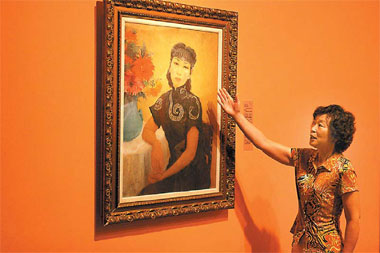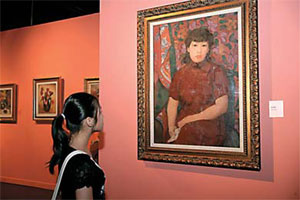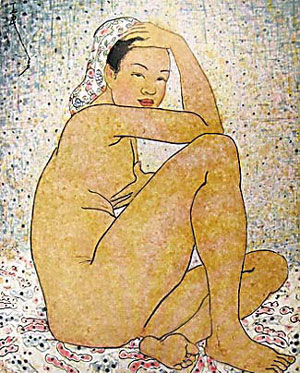Huang Xiuying, vice-curator of Anhui Museum, explains one of Pan Yuliang's self-portaits to visitors.
In a biopic released in 1994, Gong Li played Pan Yuliang, the late female painter known in China more for her legendry life than her artistic achievements. The scene that she sketched in a public bathroom caused a big stir in China then. Nine years later, another beautiful actress, Michele Lee, brought the painter to life again in a TV drama.
But Pan, who started from a brothel and wound up in Paris as a lonely painter haunted by impoverishment and nostalgia, is not as pretty as many assume, at least not in her self-portraits. Through November 15, 200 of her works, including 10 self-portraits, will be on exhibition in the Capital Museum. Half of them have never been publicly shown before.
As soon as viewers enter the exhibition hall, they are faced with one of her most famous self-portraits. The painter has long and thin eyes, thick lips and a nose like lion. By Chinese or Western standards, she is not a typical beauty. In black cheongsam with a golden dragon pattern, she sits beside a vase with crimson-colored flowers against a light yellow background - decent, quiet and a bit melancholy.
A visitor to the Capital Museum in Beijing enjoys another self-portrait of Pan Yuliang.
She painted the piece in France in 1940, when her motherland was invaded by Japanese troops.
According to Huang Xiuying, vice-curator of Anhui Museum, which collected almost all of Pan's works, most of Pan's self-portraits reflect her sadness.
Pan Yuliang's original family name was Zhang. Born in 1895, she was sold to a brothel at 13, where she later met Pan Zanhua, a customs official. Pan bought her out and married her as a concubine. Out of gratitude, she changed her family name to Pan.
She started learning painting from their neighbor Hong Ye, a teacher at Shanghai Art Institute, then one of the most avant-garde art schools in China.
Liu Haisu, a friend of Pan Zanhua and headmaster of the school, appreciated Pan Yuliang's talent and encouraged her to apply for his school. Later Pan became the first female student of the school.
She loved to paint nude portraits, which was still a taboo in China then. She had to go to public bathrooms to do sketches.
Dozens of works in the exhibition are Pan's portraits of human bodies, most of which are women.
"When she was a prostitute, her body was others' tool; there is no soul," says Huang. "But in the artistic world, the body is a respected artwork. It's not hard to understand her complicated and deep feelings for human bodies."
A nude painting by Pan Yuliang. Dozens of works in the exhibition are Pan's portraits of human bodies, of which most are women.
In 1921, Pan left for Paris to further her painting studies. Nine years later, she came back to China as a professor of Liu's school.
But in 1935, she had to leave China again due to something that happened during her fifth solo exhibition. Someone tore up a piece depicting a strong man moving a stone to let a small flower under it grow up, and wrote: "This is a prostitute's carol to a whoremonger".
Although she had been so devoted to art, there was someone who had not forgotten her early experience as a prostitute. In 1938, she left China again.
Most pieces in the exhibition were created during her stay in France. She boldly tried a combination of Chinese water and ink painting, and the composition of oil painting. She used colored water and ink spots and lines as the background, while the main characters are drawn using oil painting techniques.
In some works, such as Kite Flying and Fan Dancing, there are also elements of traditional Chinese New Year pictures, sculptures and engraving.
Critics say that her works combine both oriental and Western painting styles, and are full of her own spirit. She has contributed much to modern art with her depiction of the world with hints of Chinese calligraphy and painting.
In Paris, she was known as "Three No" lady, which means no French nationality, no lover and no contract with the galleries. She wanted to be an independent artist, although she suffered from poverty and loneliness.
Many works in and after the 1950s were in colored-ink. Huang of Anhui Museum says that Pan did not have enough money to buy materials for oil painting, so she used relatively cheap water ink. Sometimes she even had to use the same paper several times.
But these works should not be underestimated, says Huang, who believes that they are unique.
In her last days, Pan missed her homeland bitterly. Every time she wrote a letter home, she would express her yearning to return. But the French government did not allow her to take her works with her, while poor health and the "cultural revolution" (1966-76) in China postponed her journey again and again. In 1977, she died in an attic in suburban Paris, leaving about 4,000 artworks behind.
(China Daily September 5, 2007)




